2001 NISSAN X-TRAIL oil pressure
[x] Cancel search: oil pressurePage 3417 of 3833
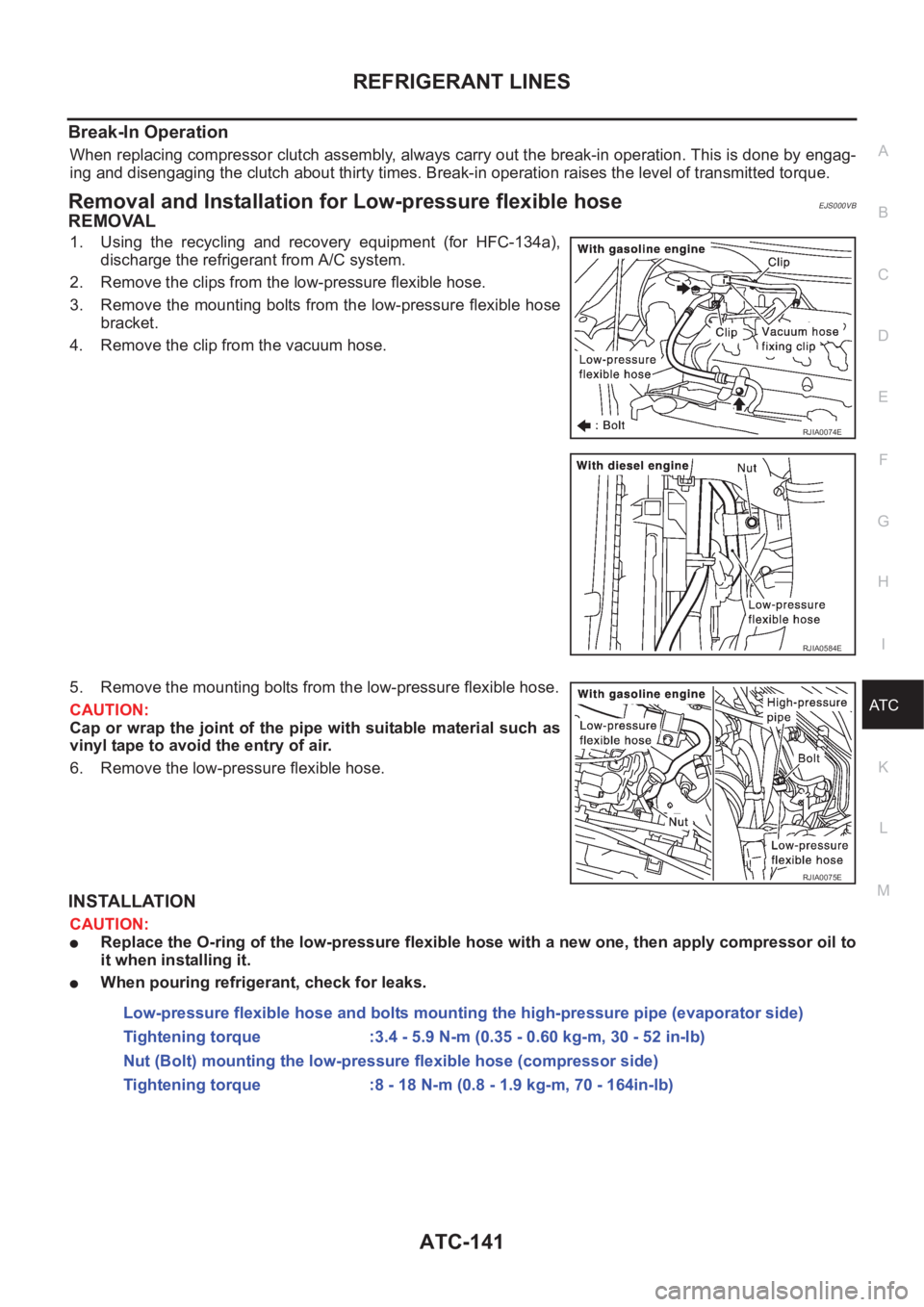
REFRIGERANT LINES
ATC-141
C
D
E
F
G
H
I
K
L
MA
B
AT C
Break-In Operation
When replacing compressor clutch assembly, always carry out the break-in operation. This is done by engag-
ing and disengaging the clutch about thirty times. Break-in operation raises the level of transmitted torque.
Removal and Installation for Low-pressure flexible hoseEJS000VB
REMOVAL
1. Using the recycling and recovery equipment (for HFC-134a),
discharge the refrigerant from A/C system.
2. Remove the clips from the low-pressure flexible hose.
3. Remove the mounting bolts from the low-pressure flexible hose
bracket.
4. Remove the clip from the vacuum hose.
5. Remove the mounting bolts from the low-pressure flexible hose.
CAUTION:
Cap or wrap the joint of the pipe with suitable material such as
vinyl tape to avoid the entry of air.
6. Remove the low-pressure flexible hose.
INSTALLATION
CAUTION:
●Replace the O-ring of the low-pressure flexible hose with a new one, then apply compressor oil to
it when installing it.
●When pouring refrigerant, check for leaks.
RJIA0074E
RJIA0584E
RJIA0075E
Low-pressure flexible hose and bolts mounting the high-pressure pipe (evaporator side)
Tightening torque :3.4 - 5.9 N-m (0.35 - 0.60 kg-m, 30 - 52 in-lb)
Nut (Bolt) mounting the low-pressure flexible hose (compressor side)
Tightening torque :8 - 18 N-m (0.8 - 1.9 kg-m, 70 - 164in-lb)
Page 3418 of 3833

ATC-142
REFRIGERANT LINES
Removal and Installation for High-pressure flexible hose
EJS000VC
REMOVAL
1. Using the recycling and recovery equipment (for HFC-134a),
discharge the refrigerant from A/C system.
2. Remove the mounting bolt and nut from the high-pressure flexi-
ble hose, then remove it.
CAUTION:
Cap or wrap the joint of the pipe with suitable material such as
vinyl tape to avoid the entry of air.
INSTALLATION
CAUTION:
●Replace the O-ring of the high-pressure flexible hose with a new one, then apply compressor oil to
it when installing it.
●When pouring refrigerant, check for leaks.
Removal and Installation for High-pressure pipeEJS000VD
REMOVAL
1. Using the recycling and recovery equipment (for HFC-134a),
discharge the refrigerant from A/C system.
2. Remove the low-pressure flexible hose.
3. Remove the high-pressure pipe from the clip.
4. Remove the mounting bolt from the high-pressure pipe.
5. Remove the high-pressure pipe.
CAUTION:
Cap or wrap the joint of the pipe with suitable material such as
vinyl tape to avoid the entry of air.
INSTALLATION
CAUTION:
●Replace the O-ring of the high-pressure pipe with a new one, then apply compressor oil to it when
installing it.
●When pouring refrigerant, check for leaks.
RJIA0076E
Bolt and nut mounting the high-pressure flexible hose
Tightening torque :8 - 18 N-m (0.8 - 1.9 kg-m, 70 - 164in-lb)
RJIA0077E
RJIA0078E
Bolts mounting the high-pressure pipe (condenser side, evaporator side)
Tightening torque :3.4 - 5.9 N-m (0.35 - 0.60 kg-m, 30 - 52 in-lb)
Page 3419 of 3833

REFRIGERANT LINES
ATC-143
C
D
E
F
G
H
I
K
L
MA
B
AT C
Removal and Installation for Refrigerant Pressure SensorEJS00288
1. Use refrigerant collecting equipment (for HFC-134a) to discharge refrigerant.
2. Remove the condenser, then remove the liquid tank. Refer to
ATC-143, "
Removal and Installation for Condenser" .
3. Using a vise, secure liquid tank, and remove pressure switch.
CAUTION:
● When working, be careful not to damage the compressor
fan.
●Apply compressor oil to the O-ring of the refrigerant pres-
sure sensor when installing it.
Removal and Installation for Dual-pressure SwitchEJS00289
1. Use refrigerant collecting equipment (for HFC-134a) to dis-
charge refrigerant.
2. Remove the condenser, then remove the liquid tank. Refer to
ATC-143, "
Removal and Installation for Condenser" .
3. Using a vise, secure liquid tank, and remove pressure switch.
CAUTION:
● When working, be careful not to damage the compressor
fan.
●Apply compressor oil to the O-ring of the refrigerant pres-
sure sensor when installing it.
Removal and Installation for CondenserEJS0028A
REMOVAL
1. Use the refrigerant collecting equipment (for HFC-134a) to dis-
charge the refrigerant from A/C system.
2. Disconnect the high-pressure flexible hose and the high-pres-
sure pipe from the condenser.
CAUTION:
Cap or wrap the joint of the pipe with suitable material such
as vinyl tape to avoid the entry of air.
3. Remove the battery and battery tray.Tightening torque :9.8 - 11.0 N·m (1.0 - 1.2kg·m, 7.3 -
8.6 ft-lb)
RJIA0698E
Tightening torque :9.8 - 11.0 N·m (1.0 - 1.2kg·m, 7.3 - 8.6 ft-lb)
RJIA0699E
RJIA0080E
Page 3420 of 3833
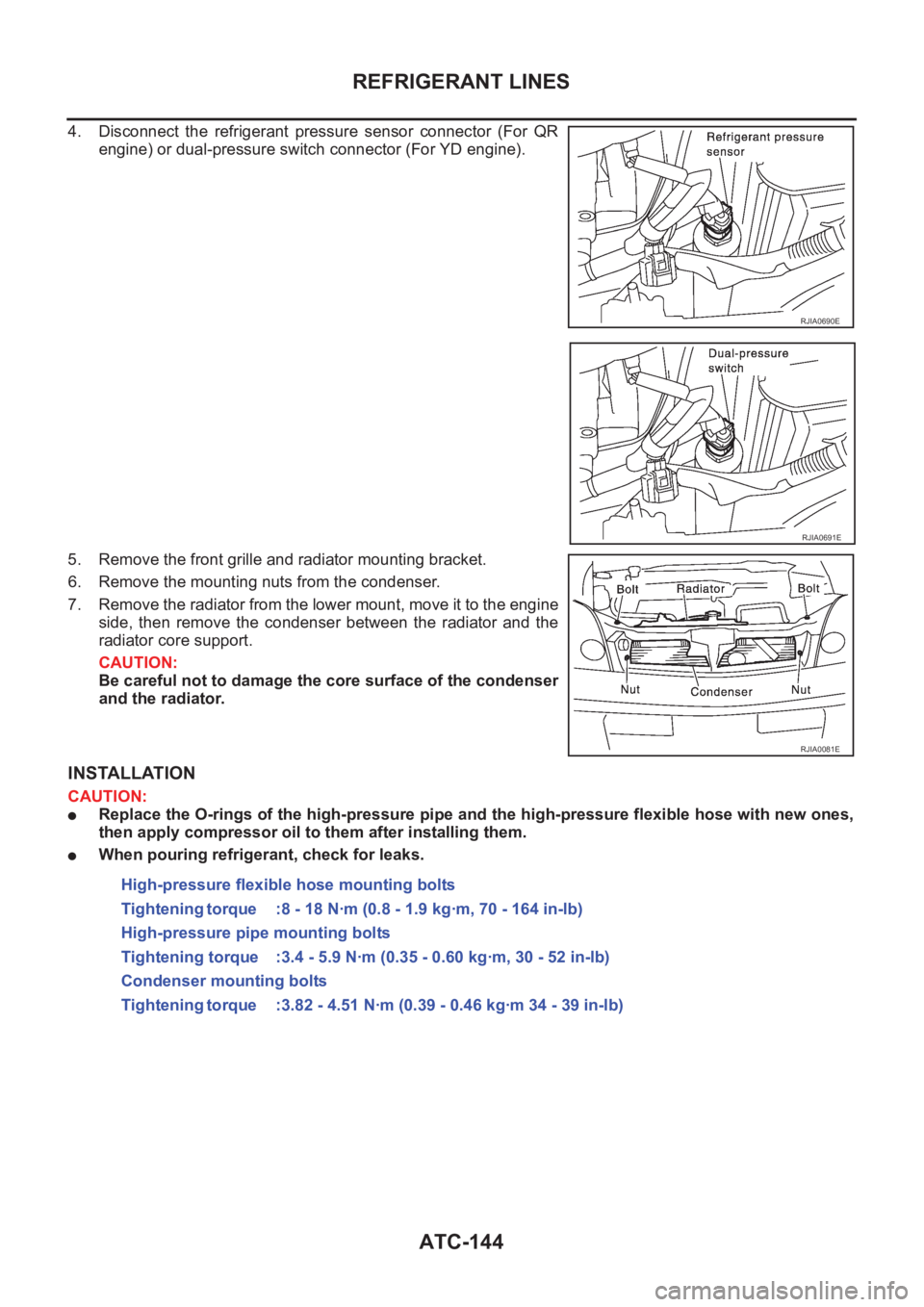
ATC-144
REFRIGERANT LINES
4. Disconnect the refrigerant pressure sensor connector (For QR
engine) or dual-pressure switch connector (For YD engine).
5. Remove the front grille and radiator mounting bracket.
6. Remove the mounting nuts from the condenser.
7. Remove the radiator from the lower mount, move it to the engine
side, then remove the condenser between the radiator and the
radiator core support.
CAUTION:
Be careful not to damage the core surface of the condenser
and the radiator.
INSTALLATION
CAUTION:
●Replace the O-rings of the high-pressure pipe and the high-pressure flexible hose with new ones,
then apply compressor oil to them after installing them.
●When pouring refrigerant, check for leaks.
RJIA0690E
RJIA0691E
RJIA0081E
High-pressure flexible hose mounting bolts
Tightening torque :8 - 18 N·m (0.8 - 1.9 kg·m, 70 - 164 in-lb)
High-pressure pipe mounting bolts
Tightening torque :3.4 - 5.9 N·m (0.35 - 0.60 kg·m, 30 - 52 in-lb)
Condenser mounting bolts
Tightening torque :3.82 - 4.51 N·m (0.39 - 0.46 kg·m 34 - 39 in-lb)
Page 3421 of 3833
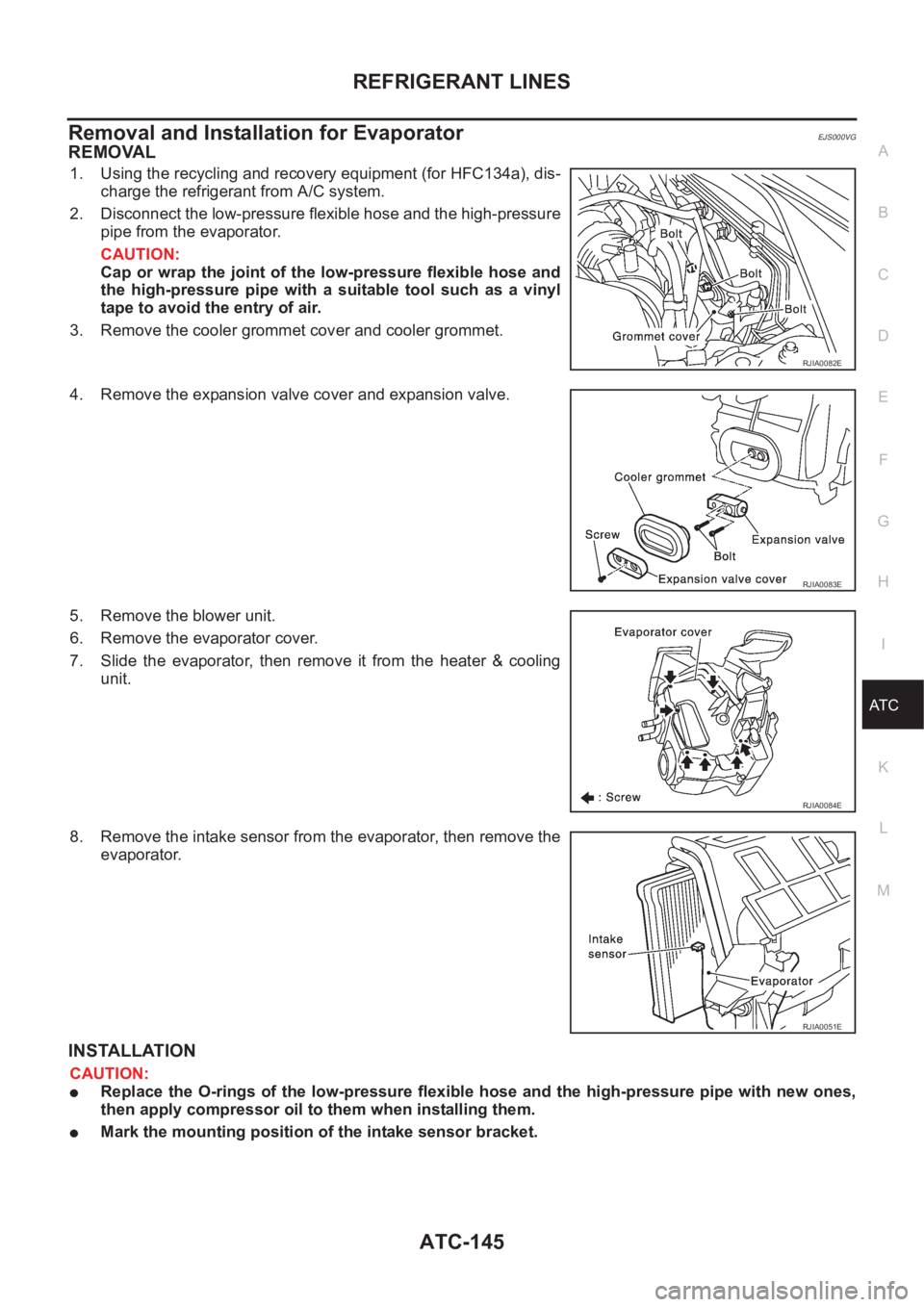
REFRIGERANT LINES
ATC-145
C
D
E
F
G
H
I
K
L
MA
B
AT C
Removal and Installation for EvaporatorEJS000VG
REMOVAL
1. Using the recycling and recovery equipment (for HFC134a), dis-
charge the refrigerant from A/C system.
2. Disconnect the low-pressure flexible hose and the high-pressure
pipe from the evaporator.
CAUTION:
Cap or wrap the joint of the low-pressure flexible hose and
the high-pressure pipe with a suitable tool such as a vinyl
tape to avoid the entry of air.
3. Remove the cooler grommet cover and cooler grommet.
4. Remove the expansion valve cover and expansion valve.
5. Remove the blower unit.
6. Remove the evaporator cover.
7. Slide the evaporator, then remove it from the heater & cooling
unit.
8. Remove the intake sensor from the evaporator, then remove the
evaporator.
INSTALLATION
CAUTION:
●Replace the O-rings of the low-pressure flexible hose and the high-pressure pipe with new ones,
then apply compressor oil to them when installing them.
●Mark the mounting position of the intake sensor bracket.
RJIA0082E
RJIA0083E
RJIA0084E
RJIA0051E
Page 3422 of 3833
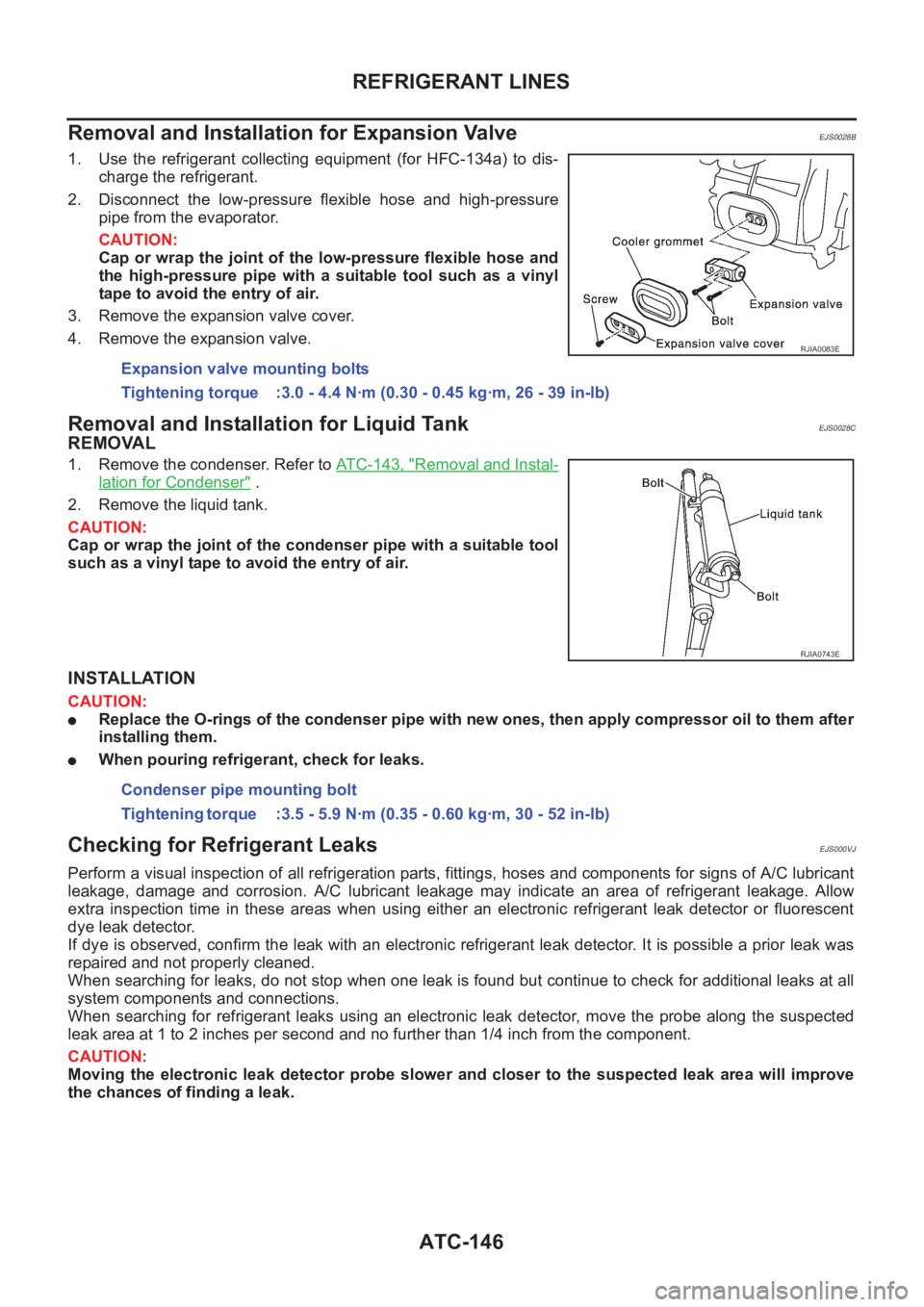
ATC-146
REFRIGERANT LINES
Removal and Installation for Expansion Valve
EJS0028B
1. Use the refrigerant collecting equipment (for HFC-134a) to dis-
charge the refrigerant.
2. Disconnect the low-pressure flexible hose and high-pressure
pipe from the evaporator.
CAUTION:
Cap or wrap the joint of the low-pressure flexible hose and
the high-pressure pipe with a suitable tool such as a vinyl
tape to avoid the entry of air.
3. Remove the expansion valve cover.
4. Remove the expansion valve.
Removal and Installation for Liquid TankEJS0028C
REMOVAL
1. Remove the condenser. Refer to ATC-143, "Removal and Instal-
lation for Condenser" .
2. Remove the liquid tank.
CAUTION:
Cap or wrap the joint of the condenser pipe with a suitable tool
such as a vinyl tape to avoid the entry of air.
INSTALLATION
CAUTION:
●Replace the O-rings of the condenser pipe with new ones, then apply compressor oil to them after
installing them.
●When pouring refrigerant, check for leaks.
Checking for Refrigerant LeaksEJS000VJ
Perform a visual inspection of all refrigeration parts, fittings, hoses and components for signs of A/C lubricant
leakage, damage and corrosion. A/C lubricant leakage may indicate an area of refrigerant leakage. Allow
extra inspection time in these areas when using either an electronic refrigerant leak detector or fluorescent
dye leak detector.
If dye is observed, confirm the leak with an electronic refrigerant leak detector. It is possible a prior leak was
repaired and not properly cleaned.
When searching for leaks, do not stop when one leak is found but continue to check for additional leaks at all
system components and connections.
When searching for refrigerant leaks using an electronic leak detector, move the probe along the suspected
leak area at 1 to 2 inches per second and no further than 1/4 inch from the component.
CAUTION:
Moving the electronic leak detector probe slower and closer to the suspected leak area will improve
the chances of finding a leak.Expansion valve mounting bolts
Tightening torque :3.0 - 4.4 N·m (0.30 - 0.45 kg·m, 26 - 39 in-lb)
RJIA0083E
RJIA0743E
Condenser pipe mounting bolt
Tightening torque :3.5 - 5.9 N·m (0.35 - 0.60 kg·m, 30 - 52 in-lb)
Page 3423 of 3833
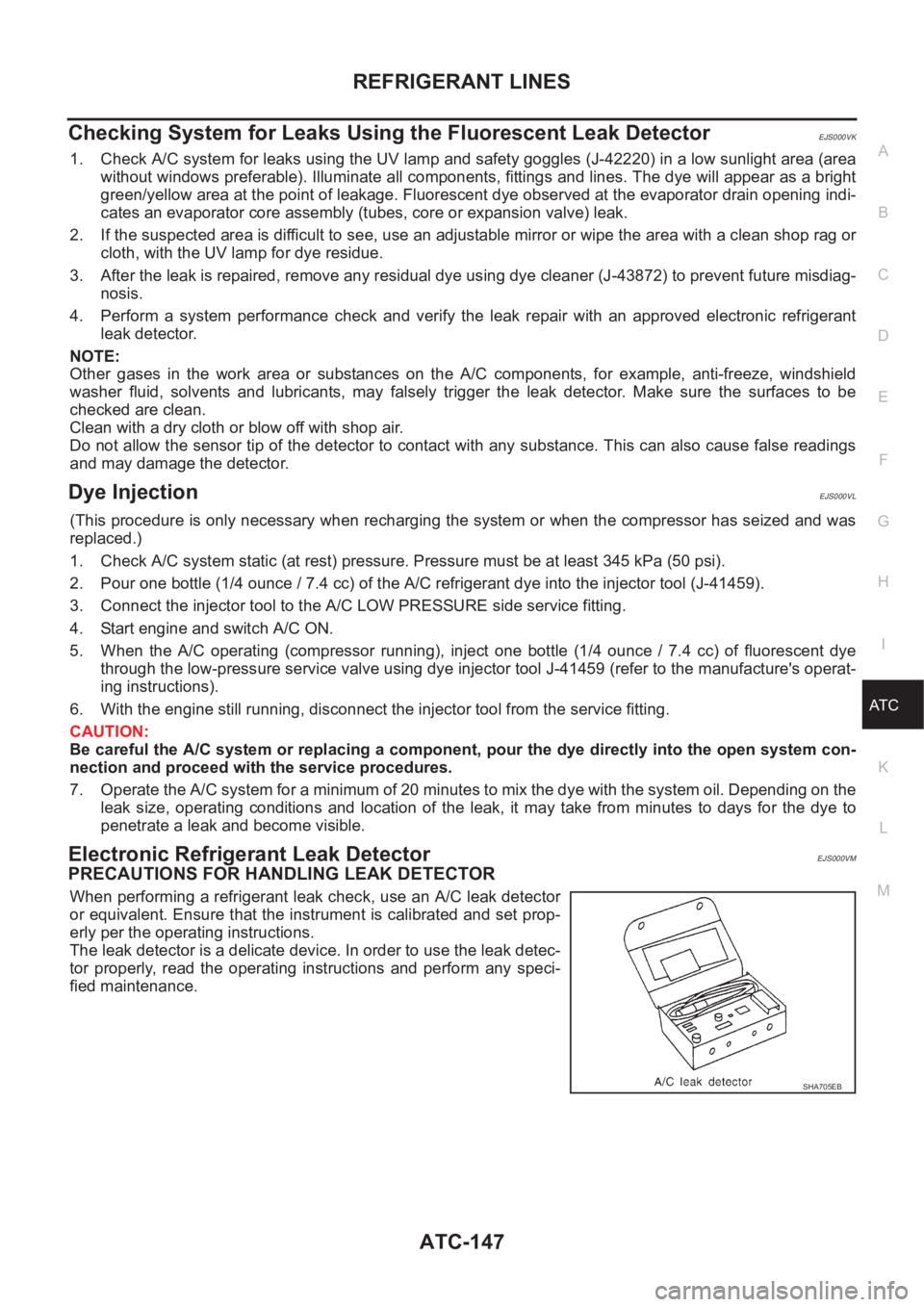
REFRIGERANT LINES
ATC-147
C
D
E
F
G
H
I
K
L
MA
B
AT C
Checking System for Leaks Using the Fluorescent Leak DetectorEJS000VK
1. Check A/C system for leaks using the UV lamp and safety goggles (J-42220) in a low sunlight area (area
without windows preferable). Illuminate all components, fittings and lines. The dye will appear as a bright
green/yellow area at the point of leakage. Fluorescent dye observed at the evaporator drain opening indi-
cates an evaporator core assembly (tubes, core or expansion valve) leak.
2. If the suspected area is difficult to see, use an adjustable mirror or wipe the area with a clean shop rag or
cloth, with the UV lamp for dye residue.
3. After the leak is repaired, remove any residual dye using dye cleaner (J-43872) to prevent future misdiag-
nosis.
4. Perform a system performance check and verify the leak repair with an approved electronic refrigerant
leak detector.
NOTE:
Other gases in the work area or substances on the A/C components, for example, anti-freeze, windshield
washer fluid, solvents and lubricants, may falsely trigger the leak detector. Make sure the surfaces to be
checked are clean.
Clean with a dry cloth or blow off with shop air.
Do not allow the sensor tip of the detector to contact with any substance. This can also cause false readings
and may damage the detector.
Dye InjectionEJS000VL
(This procedure is only necessary when recharging the system or when the compressor has seized and was
replaced.)
1. Check A/C system static (at rest) pressure. Pressure must be at least 345 kPa (50 psi).
2. Pour one bottle (1/4 ounce / 7.4 cc) of the A/C refrigerant dye into the injector tool (J-41459).
3. Connect the injector tool to the A/C LOW PRESSURE side service fitting.
4. Start engine and switch A/C ON.
5. When the A/C operating (compressor running), inject one bottle (1/4 ounce / 7.4 cc) of fluorescent dye
through the low-pressure service valve using dye injector tool J-41459 (refer to the manufacture's operat-
ing instructions).
6. With the engine still running, disconnect the injector tool from the service fitting.
CAUTION:
Be careful the A/C system or replacing a component, pour the dye directly into the open system con-
nection and proceed with the service procedures.
7. Operate the A/C system for a minimum of 20 minutes to mix the dye with the system oil. Depending on the
leak size, operating conditions and location of the leak, it may take from minutes to days for the dye to
penetrate a leak and become visible.
Electronic Refrigerant Leak DetectorEJS000VM
PRECAUTIONS FOR HANDLING LEAK DETECTOR
When performing a refrigerant leak check, use an A/C leak detector
or equivalent. Ensure that the instrument is calibrated and set prop-
erly per the operating instructions.
The leak detector is a delicate device. In order to use the leak detec-
tor properly, read the operating instructions and perform any speci-
fied maintenance.
SHA705EB
Page 3489 of 3833

SERVICE DATA AND SPECIFICATIONS (SDS)
SC-33
C
D
E
F
G
H
I
J
L
MA
B
SC
SERVICE DATA AND SPECIFICATIONS (SDS)PFP:00030
BatteryEKS0031Q
StarterEKS0031R
AlternatorEKS0031S
Applied model QR20, QR25 engine
YD22 engine Except for Northern Europe
For Northern Europe
Standard Option
Type 55D23L 80D26L 110D26L
Capacity V-AH 12-48 12-55 12-64
TypeS114-844 M0T87081 M8T71471
HITACHI make MITSUBISHI make
Reduction
Applied modelQR20, QR25 engine
YD22 engine
A/T M/T
System voltage V12
No-loadTerminal voltage V 11.0
Current A Less than 90 Less than 90 Less than 145
Revolution rpm More than 2,700 More than 2,500 More than 3,300
Minimum diameter of commutator mm (in) 28.0 (1.102) 28.8 (1.134) 31.4 (1.236)
Minimum length of brush mm (in) 10.5 (0.413) 7.0 (0.276) 11.0 (0.433)
Brush spring tension N (kg, lb) 16.2(1.65, 3.64)15.0 - 20.4(1.5 - 2.1, 3.4
- 4.6)26.7 - 36.1(2.7 - 3.7, 6.0
- 8.2)
Clearance between bearing metal and armature
shaft mm (in)Less than 0.2 (0.008) —
Clearance “l” between pinion front edge and pinion
stopper mm (in)0.3 - 2.5 (0.012 - 0.098) 0.5 - 2.0(0.020 - 0.079) —
Movement “l” in height of pinion assembly mm (in) — 0.5 - 2.0(0.020 - 0.079)
TypeLR1110-713 A3TB0771
HITACHI make MITSUBISHI make
Applied model QR20, QR25 engine YD22 engine
Nominal rating V-A 12-110 12-90
Ground polarityNegative
Minimum revolutions under no-load (When 13.5V is
applied) rpmLess than 1,100 Less than 1,300
Hot output current (When 13.5V is applied) A/rpmMore than35/1,300
More than91/2,500
More than110/5,000More than29/1,300
More than76/2,500
More than88/5,000
Regulated output voltage V 14.1 - 14.7
Minimum length of brush mm (in) More than 6.0 (0.236) More than 5.0 (0.197)
Brush spring pressure N (g, oz) 1.0 - 3.43 (102 - 350, 3.60 - 12.34) 4.8 - 6.0 (490 - 610, 17.28 - 21.51)
Slip ring minimum diameter mm (in) More than 26.0 (1.024) More than 22.1 (0.870)
Rotor coil resistance at 20° (68°F) Ω2.31 2.1 - 2.5